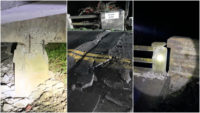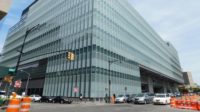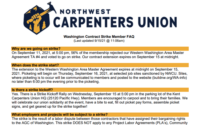After a Nov. 11 fire shut down a portion of Interstate 10 in Los Angeles, officials worried demolition and replacement of the 450-ft span of elevated freeway could take six months or more. But the damage turned out to not be as bad as initially feared, and round-the-clock emergency repairs allowed the road to reopen Nov. 19 after just eight days, ahead of the Monday morning commute and Thanksgiving week travel.
The stretch of I-10 between Alameda Street and the East Los Angeles interchange carries about 300,000 vehicles per day, according to the California Dept. of Transportation (Caltrans). More than 250 people worked 12-hour shifts totaling 10,000 labor hours in order to expedite the work, Caltrans and Gov. Gavin Newsom (D) said.
Crews removed about 264,000 cu yd of debris after the fire. Workers then installed temporary shoring consisting of 12 in. x 12 in. wood posts and 100 tons of steel beams using dozens of hydraulic jacks. They also repaired damaged electrical systems, lane striping and signs and positioned K-rail temporary concrete barriers ahead of the reopening.
After Caltrans determined the section of I-10 could be repaired rather than replaced, initial estimates set the timeline at three to five weeks. But structural testing showed that only seven rows of pillars under the elevated roadway needed shoring, as opposed to the 14 rows first predicted. Officials also attributed the speedy reopening to the efforts of crews and engineers, rapid debris removal that shaved two or three days off the schedule and close coordination that kept everything advancing.
While the freeway was closed, Caltrans workers used the opportunity to do maintenance work in the area such as repairing bridge railings, painting over graffiti and cleaning drains, according to the governor’s office.
“The work that happened here is extraordinary,” Vice President Kamala Harris said at a press conference the day of the reopening. “And it really is a function of the will and the ambition of the workers on the ground who understood what closure of the 10 would mean for folks on a daily basis, and their commitment as public servants, as union members, to get this thing done.”
Caltrans hired Westlake Village, Calif.-based Security Paving Co. and Griffith Co. of Brea, Calif., for the emergency repairs. The contractors did not immediately respond to inquiries, but a Caltrans spokesperson says Security Paving will stay on for the full repair project.
The remaining repairs are expected to take “many weeks, maybe a few months,” Newsom said. The plan involves replacing the temporary shoring with permanent shoring and concrete work to repair the damaged columns. The columns will also be wrapped in steel casings. The work may involve some temporary road closures, but Newsom said they would be limited to overnight hours when possible in order to minimize the impact. The westbound off-ramp at Alameda Street also remains closed for the repairs.
The cost of the project is still being assessed, Newsom said. Sen. Alex Padilla (D-Calif.) estimated it at close to $3 million, the amount initially supplied by the Federal Highway Administration in quick release funding for the emergency work. The agency’s Emergency Relief Program will fully cover costs to reopen the highway, and 90% of costs for remaining work. That’s similar to the funding formula used when a section of Interstate 95 in Philadelphia was destroyed by a fire earlier this year.
“The bottom line is, this will be covered by federal funds thanks to the bipartisan infrastructure law that was passed and signed a couple of years ago,” Padilla said. “The emergency fund is a result of this law, which is in and of itself a once-in-a-generation investment in our nation’s infrastructure.”
The fire that temporarily closed the freeway is still under investigation, but the California Department of Forestry and Fire Protection (Cal Fire) says it suspects arson. On Nov. 18, officials released photos of a person of interest they are seeking.
The space under the freeway is leased through Caltrans’ Airspace and Telecommunications Licensing Program to Apex Development Inc. Two months before the fire, Caltrans sued Apex in an effort to remove the company from the property for allegedly failing to pay its rent and subletting the site without authorization. A hearing in that case is scheduled for January.
Newsom said Apex had a total of five airspace leases. The state has now taken over the site of the fire and three of the others leased by the company.
The governor also directed Caltrans and Cal Fire to review the airspace program and other sites leased throughout the state. Newsom said initial results may be released as soon as Nov. 22.






Post a comment to this article
Report Abusive Comment